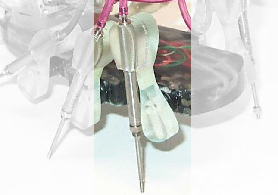|
|
|
|
|
|
|
|
|
|
| Model
|
|
 Figure 8 Close up of Sprawlita Leg |
The dynamic model considered here is a rigid body with six legs in the horizontal plane. Each leg is a prismatic joint with a spring and a damper element in parallel. Each leg is attached to the body through a rotational spring and a rotational damper.
This model is motivated by the simplified configuration of our robots. Each leg in the robot consists of a prismatic pneumatic piston attached to a compliant viscoelastic hip joint (see Figure 8). This configuration, in turn, was motivated by findings that legs in the cockroach act as "thrusters", where the leg reaction forces tend to align along the hip joint. Each leg in the model exerts forces and a moment on the body when it is in contact with the ground. This force is the result of the damping terms and the deflections of the hip and linear springs. |
The timing of the system is modeled as a feedforward motor pattern. The dynamics of the model proceed as follow:
Each leg is attached to the body at a predetermined position in the body with respect to the center of mass. |
|
Thus, the unknowns at this point to be solved for are:
Which makes our search vector consist of 18 unknowns: X = [k1 k2 k3 b1 b2 b3 K1 K2 K3 B1 B2 B3 L1 L2 L3 A1 A2 A3] |
|
| Surprisingly, for a range of parameter values, this model results in self-stabilizing behavior. That is, when simulated, the model converges to a particular orientation and forward velocity and is robust to certain pertubations. | |